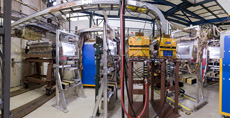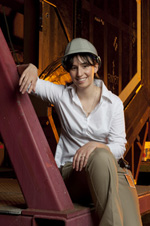Test beam facility: 500+ customers and counting

Components from the MINERvA detector were tested in Fermilab's Test Beam Facility in June of 2011. Photo: Reidar Hahn
The idea of re-using Fermilab's unique Meson Building as a next-generation beam test facility emerged from the kind of meeting where many complex issues and strategies have been discussed, argued and settled one way or another throughout the laboratory's history: Lunch.
In the Fermilab cafeteria, experimental physicists Stephen Pordes and Erik Ramberg were discussing life in general and physics in particular. Pordes mused that it would be interesting if Fermilab had a test beam facility that brought in members of the wider high-energy physics community.
"I just came right out and said I would do it," Ramberg said. So he did.
With support from the Particle Physics and Accelerator Divisions, Ramberg directed the design and installation of a new radiation-shielding wall. The Meson Test proton beam came back up in 2002.
"Then we started advertising for customers," Ramberg said.
No Fermilab project is a solo effort, and Ramberg acknowledged Leon Beverly and Todd Nebel, for their efforts in logistics and materials, and Rick Coleman, the beamline physicist, among many others getting the Fermilab Test Beam Facility open for business.
Since its makeover in 2005, with new capabilities for low energy beam, the Fermilab Test Beam Facility has staged 38 experiments, with 528 collaborators, from 119 institutions in 23 countries. In 2011 alone, there were 13 experiments, including 223 collaborators from 60 institutions in 14 countries.
Offering a test beam within the laboratory was one of the functions in the Meson area, going back to the days of the laboratory's original fixed-target program in pre-Tevatron days. The FTBF is now a proving ground for new particle detector designs being developed for new experiments at Fermilab and other accelerator laboratories in the U.S., Europe and Japan. In the future, scientists might even test particle detectors for medical imaging applications at the facility.
The FTBF is the only U.S. facility where scientists can test their designs with a beam of high energy hadrons – in this case, protons and pions. Hadrons are subatomic particles made of three quarks bound together by the strong nuclear force. The only other high energy hadron test beam is at the European research center CERN in Switzerland.

Aria Soha, the facilities manager for the Fermilab Test Beam Facility, coordinates beam time and use for experiments from all over the world. Photo: Reidar Hahn
"This future is here," said Aria Soha, who coordinates "anything and everything that needs to be coordinated" under the west side of the Meson Detector Building's unique corrugated steel roof.
There will be a direct connection to that future this month as Fermilab hosts the EDIT 2012 Symposium, a training ground for young scientists devoted to detector and instrumentation technologies. This year's symposium, attended by 64 scientists, will focus on testing detectors, including hands-on sessions at FTBF during the last two weeks of February.
Ramberg led the FTBF operation until 2009. The handoff as facilities manager went to Soha, who transferred from the Accelerator Division after working as an accelerator operator in the MCR since 2002.
"The facility has thrived under her direction," Ramberg said.
Soha's Accelerator Division experience has proved to be a big advantage.
"I know the beam, I made the beam for seven years," she said. "I can translate between the beam operators and the experimenters."
Ramberg is now head of Detector R&D. The facility is managed by the Intensity Frontier and Test Beams group of the DDO Department in PPD, which is led by Soha. The group is responsible for operational support of all the current Intensity Frontier experiments, such as MINOS, MINERvA, BooNE and SeaQuest, as well as the test beam facility.
Soha has a cadre of indispensable hands with invaluable skills in identifying and solving difficulties – Eva Skup, for instrumentation set-ups and calibrations; mechanical support from Todd Nebel and Jerry Taccki; and data acquisition (DAQ) expert Geoff Savage, who lends time from his DZero responsibilities. JJ Schmitt has recently joined as the Deputy Facility Manager, and Steve Hahn, while mostly dedicated to attending the operation of the Minos Underground experiments, lends a helping hand where he can.
Originally from New York City, Soha completed her physics degree from Carnegie-Mellon University in Pittsburgh. She joined the lab in 2002 as an accelerator operator, on the referral of another Carnegie-Mellon alum working as an operator. She's married to Aron Soha, a member of the Fermilab Web-Based Monitoring group for the Compact Muon Solenoid detector at the LHC.
In mid-tour of the FTBF, a harried experimenter searching for a BNC-LEMO connector adapter interrupts Aria.
"We're out of them," she said. "You can use a LEMO cable, or get a connector from Fermilab Stockroom, but they're $10 each."
The experimenter heads back toward his detector, pondering this connector alternative.
"Cables, tools – anything we can supply, we will," Soha said. "We want to make our users very comfortable. We'll coordinate all their needs."
And as she coordinates the experimenters' needs, Soha is helping advance future particle physics experiments, one connector at a time.
—Mike Perricone |